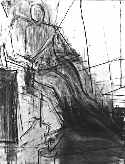Drawings By Joyce Sampson
Robert Sievert

1. Joyce Sampson: "Two Figures"

2. Joyce Sampson: "Figure And Plant"

3. Joyce Sampson: "Seated Figure"

4. Joyce Sampson: "Still Life"
One can see the construction lines that form the basis of each drawing. We were taught to divide the paper with the main axis of the plane. Once the main divisions of the compositions were found one could begin the process of establishing the interaction of volume and negative space. Line was seen as an expression of this interaction.
One can see this process at work in Joyce's double figure drawing (1). Two models sit adjacent to each other on two separate planes. The space beneath the reclining figure becomes a defining element of the picture. It moves beneath the figure into the depth of the space and returns to support the seated figure. There is a dichotomy between the depth and the flatness of this area. Clearly it moves back into depth and yet it can be read as perfectly flat to the picture plane. It is possible also to read a large volume of space between the back plane of the picture that occupies the area beyond the reclining figure and the rectangular corner in the lower right of the drawing. This volume becomes more apparent as you study the drawing and is what Hofmann called the "interval" which was the expanding part of a picture. Hofmann felt that a picture had to be expansive and the picture like the universe was constantly expanding and contained great energy if properly done.
Again, Joyce's still life drawing (4) is very instructive in illuminating the theory of plastic space. In the drawing a complicated arrangement of platforms, draperies, plants and objects is rendered in three-dimensional space, but as a flat design. There is a flow of movement through and around objects and the negative space takes on the dual nature of volume and flat area on the picture plane. One can see the same spatial themes in the work of Picasso and Gorky.
These drawings, while not student work, reflect very closely the process undertaken in Carone's classes, the absolute adherence to the Hofmann pedagogical technique. They were done in the years following our student work with Nick Carone, around 1965 or 1966.